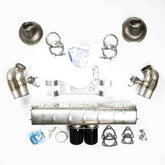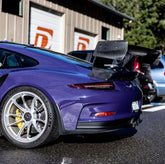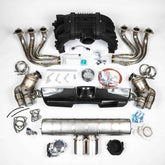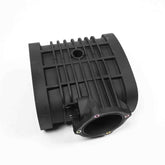991.1 GT3 Motion Control Suspension Install
Why This Upgrade Matters
Porsche engineered the 991.1 GT3 to dominate street and track, but ten years of chassis tech has marched on. If you’re chasing lap‑time parity with modern 992 GT3s—or just want razor‑sharp road feedback—the factory PASM dampers and rubber‑bushed arms are the biggest bottleneck. Dundon’s full suspension suite paired with Motion Control Suspension’s race‑bred 3‑way dampers unleashes a new handling tier:
|
Metric |
Stock 991.1 GT3 |
Dundon + MCS Package |
|
Compression/rebound clicks |
PASM “soft/firm” |
Low‑speed + high‑speed compression & rebound (10 x 18 x 18) |
|
Max ride‑height drop |
~0 mm |
~10 mm without preload loss |
|
Track‑day nitrogen tuning |
N/A |
175 psi front + rear, no street/track split, and note that altering nitrogen shifts the damper’s click-count response (so users should tune only with the adjusters) |
Table intended for quick comparison; consult Dundon for alignment recommendations tailored to tire compound and track.
What You’re About to Learn
The 45‑minute Whiskey Friday Academy episode (watch it here) walks through every bolt. This article converts that commentary into a scannable, torque‑spec‑linked workflow, enriched with pro explanations and baseline setup data so you can:
-
Remove the interior safely—even with a roll bar installed.
-
Extract the OE suspension without seized‑bolt drama.
-
Install & clock the MCS dampers (hose orientation, lift‑cup options, spanner locations).
-
Route external canisters for both street and race convenience.
-
Pressurize, align, and corner‑balance for a turnkey track shakedown.
Bookmark the free PDF torque chart in the video description; every spec called out below cross‑references that document.
The Step‑by‑Step Breakdown
1. Tooling & Prep
-
Seat removal: E12 Torx & 17 mm triple‑square.
-
Specialty must‑haves:
-
HYTORC Center‑Lock Tool – eliminates the “friend with tree‑trunk calves” holding the steering wheel.
-
Long‑reach reciprocating saw – for the infamous rear upper dog‑bone bolt installed backwards at Stuttgart.
-
¾‑drive torque wrench (up to 600 Nm) for center‑locks.
2. Interior Strip
-
Slide seats fully forward, remove rear E12 bolts, slide back, pull fronts.
-
Disconnect under‑seat yellow airbag plug (ignition off, key removed).
-
Rear carpets: hand‑lift lower edge, pop two push clips, snake through roll‑bar “triangle”.
-
Peel foam sound pad—voilà, access to rear top‑hat nuts and canister pass‑throughs.
Tip: Log fastener locations with blue tape on the carpet pieces; re‑installation is faster and rattle‑free.
3. Rear Suspension Overhaul
3.1 Wheel & Brake‑Duct Removal
-
Crack center‑lock at ride‑height (heave on HYTORC tool to factory 600 Nm release).
-
Pull brake‑cooling duct to expose lower control‑arm bolts.
3.2 Lower Control Arm & Dog‑Bone Swap
-
Unbolt LCA at knuckle; if installing dampers only, you can swing arm down, but upgrading arms unlocks +3 mm camber shim tuning—do it now.
-
Spray penetrating oil; back‑out rear sway‑bar saddle to drop bar for clearance.
3.3 Upper Arm “Bolt‑Decap” Procedure
Factory installed the inner bolt head‑first toward subframe. Options:
-
Cut head off (video demo).
-
Pull engine cradle—12 hr job.
Choose the cut; dress the shank with 240‑grit and replace with Dundon’s correctly‑oriented bolt.
3.4 Damper Removal & MCS Purge
-
Inside cabin: unplug PASM, loosen top nuts but leave engaged.
-
Wheel well: remove knuckle clamp.
-
Depressurize canister (demo at 10:45). Avoid disconnecting pressurized lines—instant rebuild required.
3.5 MCS Install & Canister Routing
-
Feed hose toward chassis, NOT knuckle; clock banjo away from bodywork.
-
Preferred line path: follow front tension arm, zip‑tie every 150 mm, pass through wheel‑arch grommet into cabin.
-
Mount PASM delete on rear bulkhead with supplied VHB tape.
4. Front Suspension Overhaul
4.1 Under‑Paneling & Pre‑Check
-
Remove six 10 mm speed nuts and T25 screws; expect debris—eye protection mandatory.
-
Inspect tie‑rod dust boots; cracked rubber? replace now.
4.2 Knuckle & Damper Extraction
-
Detach tie‑rod end (24 mm).
-
Loosen tension‑arm chassis bolt and adjacent subframe nut to prevent bind on re‑torque.
-
Hang caliper (don’t break hydraulic seal).
-
Two‑person lift: while partner supports knuckle, remove top‑hat nuts and slide assembly out.
4.3 Front MCS Install – Orientation Secrets
-
Clock the hose‑boss outward; verify banjo clears knuckle with 1 mm feeler.
-
Rotatable lower clamp: pinch point should face away from hose to maximize support.
-
Lift‑cup selection:
-
Air‑cup (stock 991.1) – silver threaded adapter removed, install barbed air fitting.
-
Hydraulic (991.2 RS, 992) – keep silver adapter; thread supply hose.
4.4 Ride‑Height & Collar Set‑Screw
-
Thread spring perch for 30 mm total adjustability.
-
Once target corner ride‑height reached, snug two 2 mm set‑screws—hand‑tight only.
Baseline front ride‑height target will vary based on your wheel and tire package, please reach out for specifics.
4.5 Lower Control Arm, Knuckle & End‑Link Best Practice
-
Transfer telemetry bracket to Dundon LCA; factory orientation preserved.
-
Sway‑bar end‑link orientation: bolt head toward knuckle, rod‑end on outermost sway‑bar hole to avoid bind on full soft. Video mis‑orientation at 31:41 intentionally shown—don’t copy it.
4.6 Tie‑Rod Turn‑Buckle Tuning
Dundon’s hex‑center tie‑rod gives 30 mm extra toe range without yanking brake ducts. Leave rack‑side jam‑nut tight; adjust toe with 22 mm wrench at center hex, then snug dual pinch bolts facing forward/up for clearance.
4.7 Canister Routing & Trunk Mount
-
Feed hose behind brake duct, through foam plug into frunk.
-
Rivet canisters high on front bulkhead—clear of fuel tank—and keep Schrader valves accessible for nitrogen service.
5. Pressurize, Torque & Align
-
Torque all hardware to PDF spec; confirm eccentric LCA bolts are at ride‑height before final torque.
-
Use rigid‑hose nitrogen inflator; hold chuck 2 s to seat.
-
Check pressures every oil service—canisters bleed 2 – 3 psi/month.
-
Alignment is very user specific and the parts have a wide range of usable settings. Please reach out to our Sales and Support Team to provide details about your use case and we will provide recommended alignment and damper settings.
Still have questions?
-
Join Whiskey Friday Live every Friday, 4:30 PM PT on YouTube—drop your install or alignment questions in chat.
Quick‑Hit FAQ
Will PASM delete trigger a dash light?
Dundon’s plug‑and‑play module keeps the ECU happy—no warning lights.
Can I retain factory front axle lift?
Yes. Specify Front-Axle Lift when ordering; the MCS lift‑cup threads directly into the damper body.
How often should I service MCS shocks?
Track‑only cars: every 40 hrs run‑time. Dual‑purpose cars: 20,000 mi or 24 months, whichever first.
Final Thoughts
The 991.1 GT3 was already a driver’s scalpel; add Dundon’s kinematics and MCS’s damper control, and you wield a track weapon that punches way above its model year. Follow the procedure, triple‑check torque, and don’t skip nitrogen and alignment—they’re the secret sauce. When you bolt the wheels back on and drop ride‑height, you’ll feel it: sharper turn‑in, mid‑corner neutrality, and traction out of slow bends you never thought possible.
Got your own install story or lap‑time delta? Comment on the Whiskey Friday Academy video or tag @dundonmotorsports on Instagram—we love a good before‑and‑after telemetry screenshot.
See you in the fast lane. 🏁






